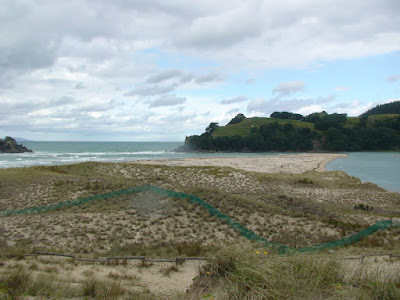From Rotorua we drove north (on March 24, 2011) to the Coromandel Peninsula. The Coromandel is a lovely place, just a bit off the tourist track, and worth anyone's time. I, though, had a specific target in mind: a rare shorebird for which the Coromandel is the last, best refuge.
The Wharekawa Harbour Sandspit Wildlife Refuge near Opoutere protects an important nesting ground for the New Zealand Dotterel (Charadrius obscurus), a species now reduced to some 1700 individuals.
New Zealand Dotterels nest on open sand beaches, and like birds of similar nesting habit elsewhere they are threatened by the fact that we humans are also attracted to such places - not to mention the risk of predator by exotic mammals that almost every New Zealand endemic faces. On the Wharekawa sand spit the birds are protected by a fine-mesh fence designed to keep out stoats, hedgehogs, cats and (one hopes) people.
The result, I was delighted to find, was that the dotterels appear to be thriving there, and once I walked down to the beach (on the permitted side of the fence, of course!) this one at least seemed not in the least put out by my presence.
This species was once considered to be a southern-hemisphere representative of the golden-plovers (genus Pluvialis), but it is now simply regarded as a large, large-billed typical sandplover (Charadrius); and, to my eye, it certainly looks like one.
The birds on the beach were quite variable in plumage; this color-ringed individual looks quite unlike the bird in the earlier pictures.
Still another individual, with differently-coloured rings, is more uniform above and whiter below than the others, and a bit shorter-billed.
A Variable Oystercatcher (Haematopus unicolor) shares the beach with the plovers.
From Opoutere we drove north, rounding the top of the peninsula to the town of Coromandel where we spent the night. The next day we continued our circumnavigation, down the rugged western side, with views across the Firth of Thames.
Rugged, sprawling Pōhutukawa trees (Metrosideros excelsa) marked the headlands....
...while Spotted Shags (Stictocarbo punctatus), including strikingly-marked adults, sat on the rocks below - beautiful birds in a lovely landscape.






















No comments:
Post a Comment